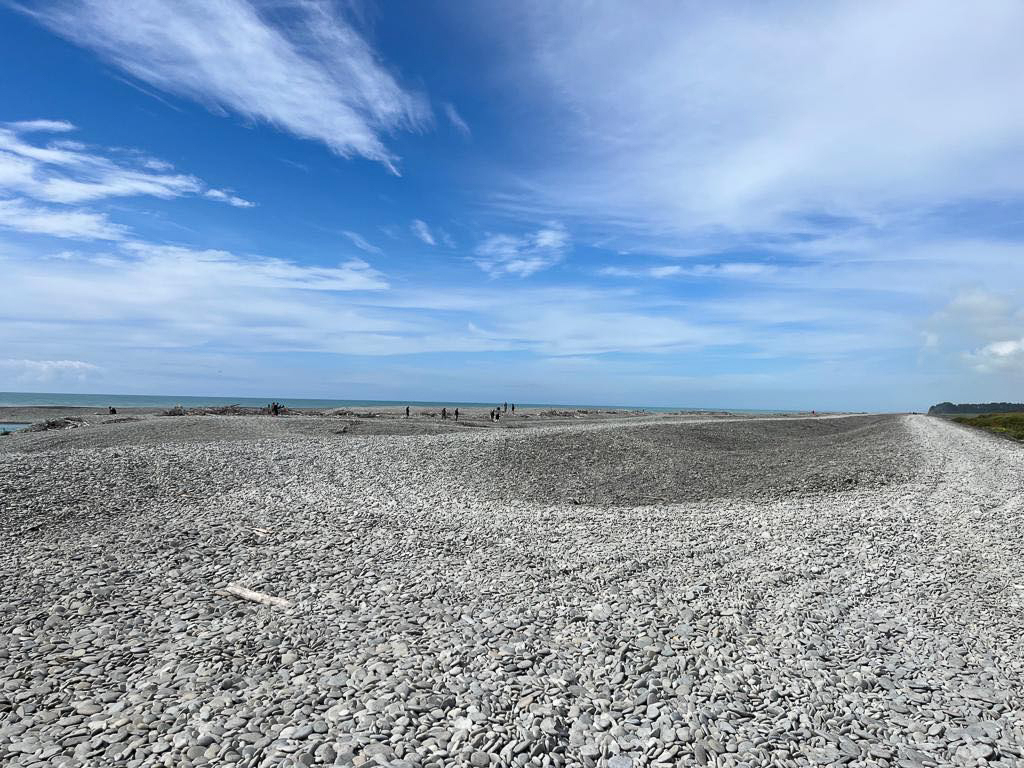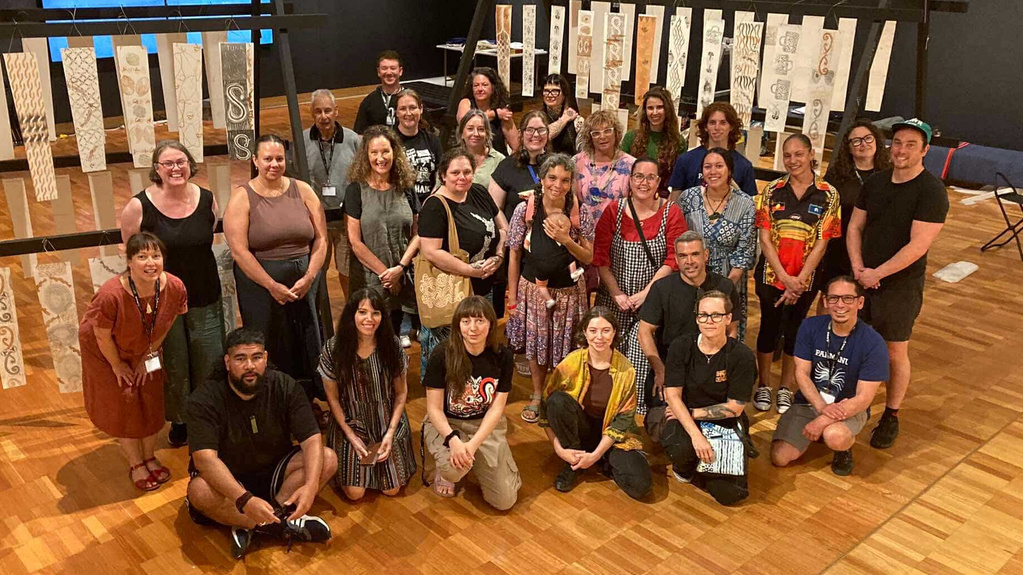Garland collaborated with Paemanu in sharing their story of the river journey that led to the participation in the 11th Asia Pacific Triennial.
Paemanu is a kin-group of Ngāi Tahu artists strengthened with the cultural leadership of senior artist Ross Hemera, their pou tokomanawa. In 2013, Paemanu was established as a trust to support and advocate for the “flourishing of Ngāi Tahu visual arts” following their first gathering in 2012 at Rāpaki, a settlement in Whakaraupō Lyttelton Harbour basin in Canterbury. Over the past decade, they have produced a number of projects within their Ngāi Tahu tribal territory in Te Waipounamu, the South Island of Aotearoa New Zealand, including recent exhibitions at Dunedin Public Art Gallery, Paemanu: Tauraka Toi – A Landing Place and Hurahia ana kā Whetū: Unveiling the Stars and the establishment of their own art collection that is available for loan. This year, they have been invited to participate in the eleventh Asia Pacific Triennial at Queensland Art Gallery | Gallery of Modern Art (QAGOMA) in Brisbane.

Paemanu artists gathered with some supporting tribal experts outside Waihao Marae (an ancestral meeting house situated north of the Waitaki River) at the beginning of the journey; photo: Conor Clarke
Representatives from the group made a visit to QAGOMA early in the process to meet with mana whenua (indigenous custodians) to make introductions, to understand the place they were visiting and what they could bring. QAGOMA is located alongside the Maiwar (Brisbane River). Upon connecting with local Yuggera and Turrbal elders, “our shared values and relationships to the environment as indigenous peoples led us to establish the conceptual framework awa ki te awa, a meeting of rivers.”
Central to their creative practice is wānaka. “Wānaka means to gather together to workshop, talk and learn together. It’s a cultural practice that is strong within Ngāi Tahu culture” Paemanu artists, who are based across Aotearoa and internationally, regularly meet by Zoom but for specific projects, they come together in person at marae, art galleries, and Ngāi Tahu sites of significance.
After many discussions about how to honour a meeting of rivers, “it became clear that connecting physically as a group to one of our own rivers was fundamental.”
They collectively decided to develop their exhibition for the triennial through a hīkoi, a journey, from the east coast of Te Waipounamu to the inland mountains. They followed the Waitaki River, which has great cultural significance for Ngāi Tahu.
The purpose of this hīkoi was to build connections:
Our intention was to connect to the land and waterways and connect to the people who were with us on this hīkoi and see how that might flow into or out of our collective and individual practices. We were able to visit many places of cultural significance, such as ana whakairo rock art sites, Aoraki Mount Cook, and Te Manahuna Mackenzie Basin. Visiting those places as a group was significant.
- Korotuaheka at the mouth of the Waitaki River
- Detail of greywacke cobblestones at the mouth of the Waitaki River.
- Visiting the Takiroa ana whakairo (rock art) site; photo: Martin Awa Clarke Langdon.
About 40 members of Paemanu arrived at the mouth of the Waitaki, where they found a beach covered in greywacke cobblestones. “It’s an amazing landscape that feels singular.”
The group learnt about moa bones and adzes that had been found as evidence of a hunting ground. Importantly, they learned the traditional name for the area, Korotuaheka. “Describing these places using the names our ancestors gave them was meaningful. It helped to ground us in the landscape through our genealogical connections.” They met with tribal experts and learnt about efforts to repopulate indigenous species along waterways and reinstate tribal narratives through identity marking, restorative native plantings, and information centres. The group met with local Waitaha elder Anne Te Maiharoa-Dodds, who spoke about her great-grandfather Te Maiharoa, a significant prophet and leader in the area.
- Paemanu artists visiting ana whakairo (rock art) sites while on hīkoi. Image: Hīkoi (still), 2024, Two-channel HD video installation
- Detail of limestone environments at ana whakairo sites. Image: Hīkoi (still), 2024, Two-channel HD video installation.
Travelling the 200-kilometre journey inland, guided by expert artists and researchers, Paemanu visited ancestral rock art sites found in limestone outcrops. “They were almost cathedral-like in their limestone lusciousness.” Visiting was understood, in part, as a kind of “warming” of the sites. This can be related to the concept of ahi kā—continuous burning fires that signalled occupation of an area.
“We have a responsibility to visit these places and contribute to maintaining a cultural warming, or ahi kā, in whatever ways we can. In our ancestors’ time, ahi kā was practical to make sure that the fire was kept warm and lit.”
- Paemanu artists walking to the base of the mountain Aoraki
- Paemanu artists walking to the base of the mountain Aoraki. Photo: Martin Awa Clarke Langdon.
- View from the Hooker Valley walking track enroute to Aoraki. Photo: Haawi Whaitiri.
- Detail of stone at Hooker Lake, by the foothills of Aoraki. Photo: Vallance Wrathall.
- Paemanu artists spotted while on hīkoi wearing matching ‘Aoraki Matatū’ hoodies; photo: Chloe Cull
Eventually, they reached their destination, the glacier at the source of the Waitaki.
“It got windier and colder and eventually lashing, icy rain arrived. It was really dramatic.”
There they stood looking out at the Hooker Lake, at the foot of their sacred mountain. Aoraki Mount Cook is acknowledged as a significant ancestor for Ngāi Tahu, often celebrated in tribal waiata (songs) and whakataukī (proverbial phrases).
There is a whakataukī “Aoraki Matatū”, which speaks to the enduring nature of the mountain. It is used widely among Ngāi Tahu people as a saying of identification and motivation.
The principle of manuhiritaka is also important to the project. It refers to the manner of being a guest. This is the first time Paemanu is taking their collaborative art practice outside of their tribal territory, and on another people’s country.
There are cultural traditions and customs related to being manuhiri, or visitors, and the practice of visiting. We’re really conscious of the importance of paying our respects to the home people when we visit and to be good manuhiri as we travel offshore.
- Installation view of Paemanu: Awa Toi (pictured artworks Tīrewa and Karaka) at Asia Pacific Triennial, 2024.
- Wānaka-ā-rohe printmaking wānaka with Paemanu artists in Te Whanganui-a-Tara (Wellington) in preparation for Asia Pacific Triennial.: photo: Martin Awa Clarke Langdon.
- Wānaka-ā-rohe printmaking wānaka with Paemanu artists in Ōtepoti (Dunedin) in preparation for Asia Pacific Triennial; photo: Dana Te Kanawa.
- Detail of printmaking devices created by Paemanu artists.
- Paemanu artists celebrating with completed Tīrewa prints made collectively in wānaka’ photo: Kitty Brown.
- Paemanu artists preparing to create prints during wānaka. Woodcuts, lino cuts, and other printmaking devices are visible in the foreground; photo: Kitty Brown.
The first collaborative work in the exhibition, which directly speaks to manuhiritaka, is titled Karaka. It consists of a number of sculptures made by some of the women of Paemanu. Karaka refers to the sung call-and-response performed on behalf of hosts and guests at the beginning of a Māori ceremonial welcome. These calls establish connections between home people and visitors.
Another artwork in the exhibition, Tīrewa, was developed following a number of printmaking workshops that took place around New Zealand. Paemanu artists were invited to create printing-making devices about what rivers mean to them which were then used to make collaborative prints. Importantly, a print exchange has been initiated with local indigenous artists and their new works added in. These are displayed on a tīrewa, a rack stylised from those used for drying eels.
A moving image work, Hīkoi, assembles imagery from those who journeyed ki tai ki uta, from sea to mountain, along the Waitaki River, a celebration of those important places and of the people.
Finally, there is Ana Whakairo, a drawing on the gallery walls by the artist group as a “continuation of the rock art traditions of our ancestors.” For the group, Paemanu: Awa Toi is the continued expression of whakapapa (ancestry) and tikanga (customs), their creative spirit and genealogical connection to land, river and each other. The artists bring their rivers to meet and merge with that and those of the Maiwar.
The quotes in this article are taken from a video conversation on 30 October 2024 and the article was jointly edited by Paemanu. Documentation of the APT exhibition and related events will be added in early December 2024.
Visit www.paemanu.co.nz and like facebook.com/profile.php?id=100064619532316
Installation at the Asia Pacific Triennial
- Paemanu artists meet with Caia artists. Image credit: Piupiu Maya
- Kāraka. Image credit: Martin Langdon
- Ana whakairo, Karaka. Image credit: Nicholas Umek
- Tīrewa. Image Credit: Nicholas Umek
- Tīrewa. Image Credit: Nicholas Umek























